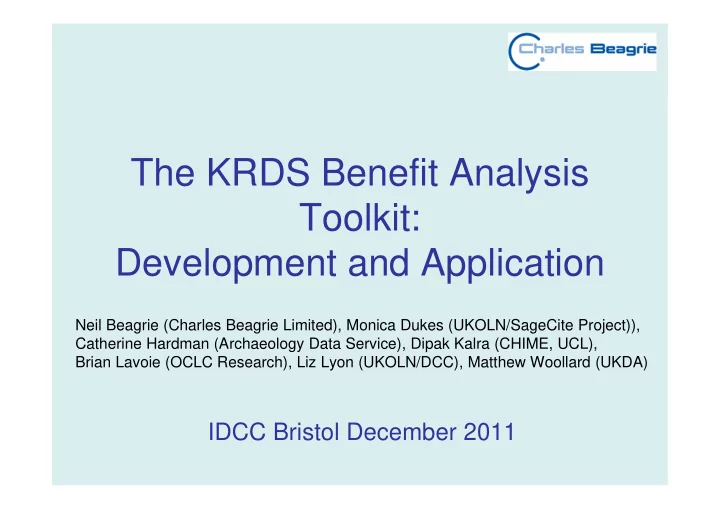

The KRDS Benefit Analysis Toolkit: Development and Application Neil Beagrie (Charles Beagrie Limited), Monica Dukes (UKOLN/SageCite Project)), Catherine Hardman (Archaeology Data Service), Dipak Kalra (CHIME, UCL), Brian Lavoie (OCLC Research), Liz Lyon (UKOLN/DCC), Matthew Woollard (UKDA) IDCC Bristol December 2011
The Benefits Analysis Toolkit
Toolkit & Components
The KRDS Benefits Framework
The Framework – Framework arranged on 3 dimensions with two sub- divisions each; Pick list of common generic benefits – Individual benefits identified and assigned within this Benefit from Curation of Research Data Internal External WHO BENEFITS?
Worksheet
Example generic benefits • Increasing research productivity • Secures value to future researchers & students • Increasing skills base of researchers/students/staff • Verification of research/research integrity • Availability of data underpinning published findings • Stimulating new networks/collaborations • New research opportunities • Motivating new research • Knowledge transfer to industry • Commercialising research
Value Chain & Impact Analysis Tool
Value Chain & Impact Analysis Tool
Combining Use of the Tools
KRDS Benefit Framework and Value Chain: a use case for archaeology Catherine Hardman Archaeology Data Service http://archaeologydataservice.ac.uk
How we can foresee use of the Benefits Framework As a repository we often have to help justify the costs/effort associated with digital preservation. The benefits worksheet (and associated guide) helps explain the benefits in structured and meaningful fashion. http://archaeologydataservice.ac.uk
How we can foresee use of the Value Chain • The issue of ‘value’ in archaeology is key • Difficult to quantify the meaning of value in different subject areas http://archaeologydataservice.ac.uk
ADS thoughts • A light touch in helping persuade projects or funders of the benefits of preservation in a structured and clear way… • Or a deeper insight into project planning decisions when dealing with finite resources. http://archaeologydataservice.ac.uk
Application of the Benefits Analysis Tools for MRC population health studies – Professor Dipak Kalra – Centre for Health Informatics and Multi-professional Education(CHIME) – University College London
Worked example: Re-purposing and re-use of data • Localised expression: Lower costs of data collection and curation, faster route to usable data • Action: Agree shared use of pre-existing data held by another study to avoid new data collection • KRDS Outcome type: Indirect benefit, in 1 year • Stakeholders: Internal: PIs, academics, data managers • Quantitative benefit: Cost saving, shorter time to publications • Qualitative benefit: ~ • Weighting: 4
Conclusions • The Benefits Framework and the Impact Tool can accommodate the kinds of benefit from good data curation practice and from data sharing in MRC population health studies • Detailing the active steps to realise each benefit, when the result might be realised and who benefits seem to be useful ingredients for putting forward a case for funding or for prioritising resource utilisation with a study • Whilst initial population might be done by one person, completing the spreadsheet and working out weightings might be nicely undertaken in a team workshop
SageCite Project Monica Duke m.duke@ukoln.ac.uk http://blogs.ukoln.ac.uk/sa gecite/ UKOLN is supported by:
What we have learnt • The benefits framework was easy to apply and helped articulate benefits • An intermediary may be required to facilitate the process • Digital Management background and motivation matters • Terminology matters
KRDS BENEFITS FRAMEWORK, VALUE-CHAIN AND BENEFIT ANALYSIS TOOLS: UK DATA ARCHIVE CASE STUDY MATTHEW MATTHEW MATTHEW MATTHEW WOOLLARD WOOLLARD WOOLLARD WOOLLARD …………………………………. …………………………………. …………………………………. …………………………………. DIRECTOR DIRECTOR DIRECTOR DIRECTOR ECONOMIC AND SOCIAL DATA SERVICE & ECONOMIC AND SOCIAL DATA SERVICE & ECONOMIC AND SOCIAL DATA SERVICE & ECONOMIC AND SOCIAL DATA SERVICE & UK DATA ARCHIVE UK DATA ARCHIVE UK DATA ARCHIVE UK DATA ARCHIVE UNIVERSITY OF ESSEX UNIVERSITY OF ESSEX UNIVERSITY OF ESSEX UNIVERSITY OF ESSEX …………………………………. …………………………………. …………………………………. ………………………………….
IMPLEMENTATION TIPS • Start with the Benefits Framework Worksheet and move on to the Value- Chain/Benefits Impact Worksheet(s) – easier to expand than reduce • Use a customised spreadsheet to sort and configure • Remember – quantitative impact of benefits must be measurable – qualitative impact of benefits can become case studies [note these can be powerful, but should be used in collaboration with quantitative evidence]. – impact weight is subjective – best developed as a team
Further Information Information Leaflet + Abstract Benefits Tools Webpage http://beagrie.com/krds-i2s2.php
Recommend
More recommend